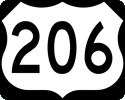There is not much to say about this highway since it is only in the Commonwealth for just under a half mile; however, it is the only US route in Pennsylvania that is maintained solely by an entity other than PennDOT. The Delaware River Joint Toll Bridge Commission has jurisdiction since the current alignment was built in conjunction with the Milford-Montague Toll Bridge.
The US 206 designation was first signed in 1934, and the first change to the route took place in 1946 when the western terminus was moved from US 6 in Milford, via a multiplex with US 209, to the end of Milford Beach Road.
Construction began on the Milford-Montague Toll Bridge on October 15, 1951, the same date work began on the Portland-Columbia and Delaware Water Gap toll bridges. It was built to replace a steel, toll-free crossing that was constructed during the horse-and-buggy era in 1889 but couldn't handle the numbers and weights of 20th Century vehicles. Alexander R. Miller, chairman of the Delaware River Joint Toll Bridge Commission, cut the ribbon on December 30, 1953. The bridge cost $4.5 million to build and was the last of the three to open. That same year, it was named as one of the ten most beautiful steel bridges in a national competition conducted by the American Institute of Steel Construction. It is 1,150-feet-long, 76 feet high, and is the northernmost bridge under the Delaware River Joint Toll Bridge Commission jurisdiction. Since the bridge was built downriver from the old span, a new roadway was built to connect to US 209 which removed the designation from Milford Beach Road.
Time began to take its toll, no pun intended, on the Milford-Montague Toll Bridge by the 21st Century. Work began in February 2008 on a project to rehabilitate the bridge which also included patching and a new asphalt surface with new shoulders on the Pennsylvania approach, additional signage added to the approaches, and replacement of the toll plaza with two new booths and a dedicated E-ZPass lane. The existing pre-cast concrete deck panels were replaced with new pre-cast concrete deck panels that were overlaid with asphalt. Several deteriorated support stringers under the deck were also replaced, and the entire superstructure under the deck was sand blasted and painted. The DRJTBC officially rededicated the bridge with a ceremony on the grounds of the Commission's administration building next to the toll plaza that included an opera singer and an antique car procession through the toll plaza. State, county, and local elected officials from New Jersey and Pennsylvania joined Commission representatives for the event which marked the end of the $19.1 million project.
When the Coronavirus, or COVID-19, pandemic swept into the country in March 2020, the Delaware River Joint Toll Bridge Commission took measures to stem the spread to their employees and staff. At 10:00 PM on March 24, all tolled bridges, including the Milford-Montague Toll Bridge, went to a cashless toll collection system. E-ZPass users would pass through the plazas as normal, and drivers who normally paid by cash were directed to the far right lane of the toll plazas and to have their license plate captured. A bill for the toll only, without additional administrative or violation fees, would then be sent to their address which would then have to be paid within 30 days or else each unpaid transaction would face a $30 violation fee. At 11 PM on May 13, the DRJTBC began accepting cash payments again. Additional safety measures were put in place, such as toll collection staff being given plastic face shields, masks, and nitrile gloves. They also encouraged drivers paying by cash to wear a face covering when using a cash lane.
It was an end of an era for the Milford-Montague Toll Bridge on June 16, 2024 when cash payments stopped being accepted at 11 PM. This span, along with the Portland-Columbia and New Hope-Lambertville toll bridges, were the first Delaware River Joint Toll Bridge Commission tolled spans to switch to all-electronic tolling (AET) utilizing only E-ZPass and TOLL BY PLATE for payments. A design contract to replace the toll plazas with gantries that have E-ZPass readers and TOLL BY PLATE cameras was awarded at the Commissions's June 24, 2024 meeting to Rummel, Klepper & Kahl, LLP (RK&K) of King of Prussia to develop two gantry designs: one for low-traffic volume toll bridges, such as the Milford-Montague, and another for high-traffic-volume toll bridges like the Interstate 78 span.
|
| Southern Entrance: | New Jersey state line at the Milford-Montague Toll Bridge in the Delaware Water Gap National Recreation Area |
| Northern Terminus: | US 209 in the Delaware Water Gap National Recreation Area |
| Length: | 0.41 miles |
| National Highway System: | Entire length |
| Names: | None |
| SR Designations: | None (route is under the jurisdiction of the Delaware River Joint Toll Bridge Commission) |
| Multiplexed Routes: | None |
| County: | Pike |
| Expressway: | None |
| Former Designations: | None |
| Former LR Designations: | None |
| Links: | E-ZPass - Delaware River Joint Toll Bridge Commission Milford-Montague Toll Bridge - Delaware River Joint Toll Bridge Commission Terminus of US 206 - Dale Sanderson US 206 Pictures - Doug Kerr US 206 Pictures - Steve Alpert |

 INFORMATION
INFORMATION